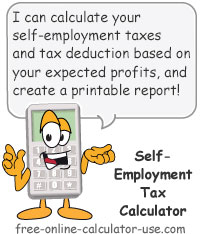IMPORTANT: Numeric entry fields must not contain dollar signs, percent signs, commas, spaces, etc. (only digits 0-9 and decimal points are allowed).
Click the Terms tab above for a more detailed description of each entry.
Step #1:
If applicable, enter your expected farm profit for the year. the description will reveal a mini-calculator for converting non-annual farm profits into annual profits.
Step #2:
If applicable, enter the annual total of any Conservation Reserve Program payments you expect to receive.
Step #3:
Enter your expected business net-profit for the year. the description will reveal a mini-calculator for converting non-annual profits into annual profits.
Step #4:
If applicable, enter your expected church employee income for the year.
Step #5:
If applicable, enter your expected social security wages and tips for the year.
Step #6:
If applicable, enter your expected unreported tips for the year.
Step #7:
If applicable, enter your expected unreported wages for the year.
Step #8:
the "Calculate SE Tax" button and scroll down to see the results, which will include a completed Self-Employment Tax and Deduction Worksheet, followed by a button to open the worksheet in a new window for printing.


Follow me on any of the social media sites below and be among the first to get a sneak peek at the newest and coolest calculators that are being added or updated each month.